The iPad Air Review
by Anand Lal Shimpi on October 29, 2013 9:00 PM ESTiPhone to iPad: CPU Changes
Although the iPad Air uses the same A7 from the iPhone 5s (and M7 motion coprocessor), there are a few minor differences that do lead to better performance.
At a high level we’re still talking about two 64-bit Apple Cyclone cores with 128KB L1s (64KB I$ + 64KB D$) per core, a shared 1MB L2 cache and a 4MB L3 cache that services the entire SoC. Apple increased CPU frequency from 1.3GHz to 1.4GHz in the iPad Air, a mild increase but in line with what we’ve seen from previous iPad designs. That’s the first impact on performance - a 7.69% increase in CPU frequency.
The second impact on performance is something I only noticed while digging around under the hood of the A7. It seems like the implementation in the iPad Air can, for whatever reason, hold more instructions in flight (over 20% more) than the A7 in the iPhone 5s. It’s unclear to me whether the A7 in the iPad is configured any differently via firmware/microcode or if perhaps we’re looking at a slightly different revision of the core, but the delta was repeatable in my testing.
The third, and likely biggest change impacting the iPad Air’s implementation of the A7 is the additional thermal headroom afforded by the larger chassis. I’m not going to go into details on exactly what this next test does (unfortunately we’re going to occlude some of the low level work that we do in light of all of the benchmark cheating going on), but we’re looking at a curve of performance vs. time for a particularly power heavy mix of code. We’re running the same exact code on both the iPad Air and iPhone 5s here, the only real difference is the size of the chassis:
You can see the 5s throttles back its CPU frequency to about 1GHz after the 2 minute mark. The crazy thing is that until that point the 5s manages to run at full frequency without so much as a hiccup for two full minutes, running an incredibly power hungry task. Given that most iOS apps aren’t this power intensive for such a sustained period of time, iPhone 5s users should almost always see the A7 running at a full 1.3GHz. Pretty crazy.
The iPad Air by comparison shows much more controlled behavior. Early on in the test we see a 7.7% performance advantage, which lines up perfectly with the iPad Air’s 7.7% CPU frequency advantage. By the end of the test the iPhone 5s has throttled to 900MHz, while the iPad Air drops to around 1.2GHz. At this point the iPad Air’s performance advantage grows to almost 40%.
CPU Performance
I've gone through our standard set of cross-platform browser based benchmarks to place the iPad Air's performance in perspective. As I mentioned in our 5s review, I don't know that there are many (any?) applications on iOS 7 that can really take advantage of all the A7 has to offer. There's definitely a ton of headroom left in the design. What's particularly exciting is when the A7 ends up in n-1 or n-2 iOS devices and it becomes the minimum developer target going forward.
I won't go through all of the results here again, but it's safe to say that the iPad Air is the fastest ARM based tablet on the planet at this point.
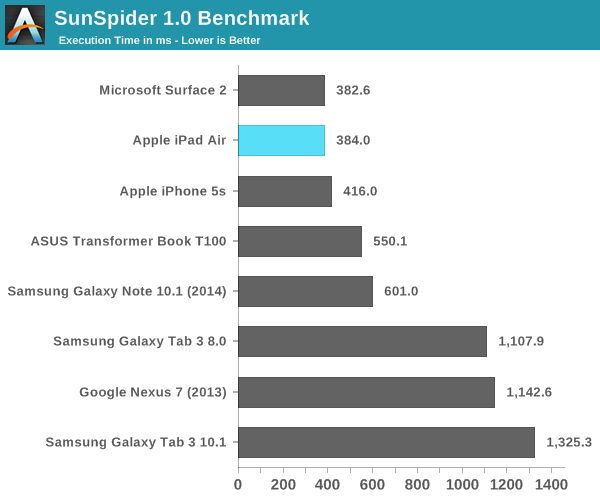
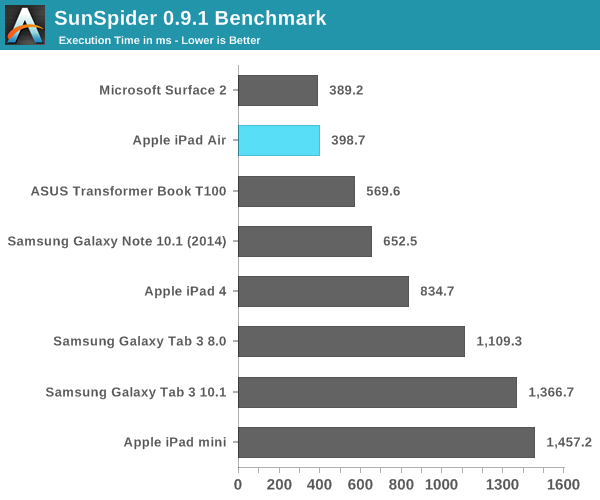
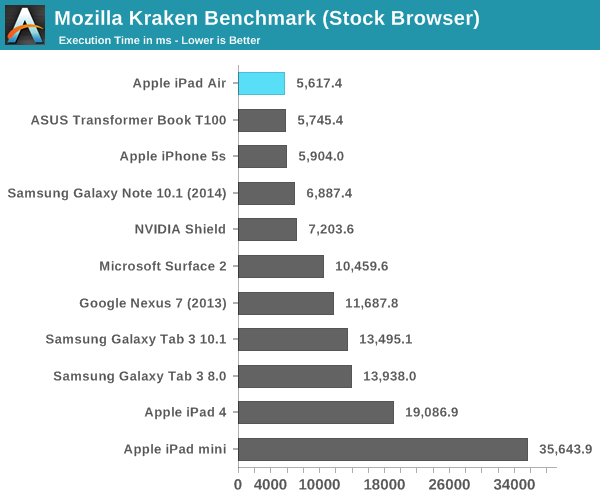
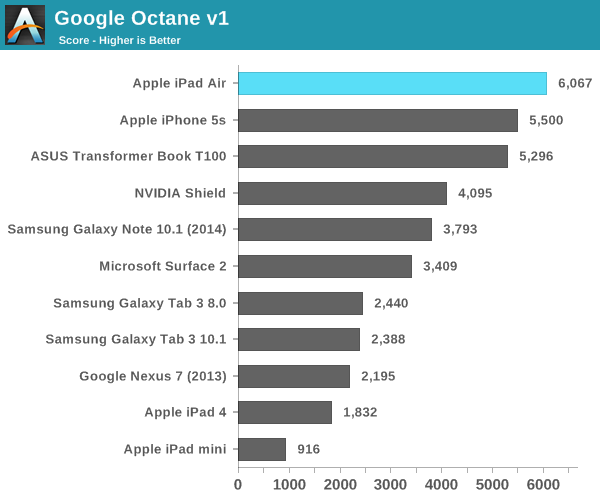
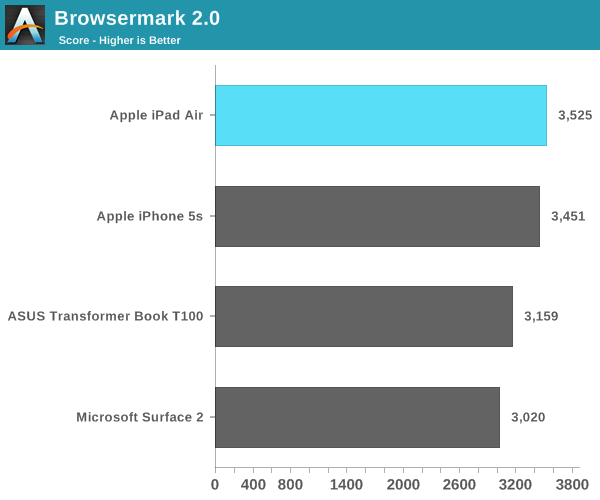

A7 Power Consumption
I’ll get to battery life in a bit, but I’ve been curious about the dynamic range of power consumption offered by Apple’s new A7 SoC. On the one hand we’re dealing with a lower power process (28nm vs. 32nm), but on the other hand Apple’s Cyclone cores can clearly draw more power given how beefy the architecture is this round. Apple frowns upon review sample dissection so I had to turn to a less scientific method of external platform level power measurement. The fidelity of the numbers here aren’t all that great but it’s better than nothing.
For the first test I measured platform power consumption during a Kraken run:
I purposely started measuring before the benchmark so I could get an idea of idle power consumption. The iPad Air consumes roughly 72% of the idle power as the iPad 4, both running at the same brightness. Here we’re not just seeing the A7’s advantages but also things like lower display power.
Focusing on the load portion of the measurement we see that both the new iPad and old iPad consume the same total power in this test. I suspect the A7 is drawing more power than the A6X, but it’s masked by a lower power display. Given how much faster the iPad Air is, Apple’s latest tablet features far lower overall task energy than the outgoing iPad 4. This is probably both the best case scenario for the iPad Air and the most likely case as well.
For kicks I wanted to see just how much power I could get the iPad Air to draw. Here I’m looking at platform power during our mini-power-virus test from above:
How’s that for dynamic range? Almost 12W running all out, but around half that in what we’d normally consider to be a stressful CPU test. I couldn’t get any actual applications/games on the iPad Air to behave like this so the results above are purely academic (for now). A quick run through GFXBench 2.7’s T-Rex HD test confirms that even pushing the GPU won’t hit these numbers. The max I saw running T-Rex offscreen was ~6W, and turning to an actual game (Infinity Blade 3) the iPad Air pulls less than 5W.


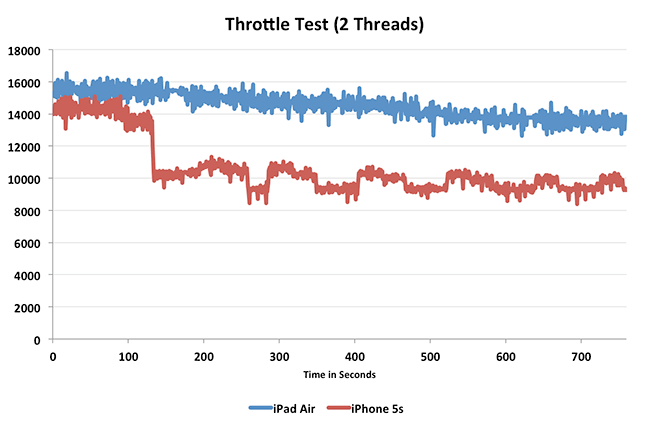
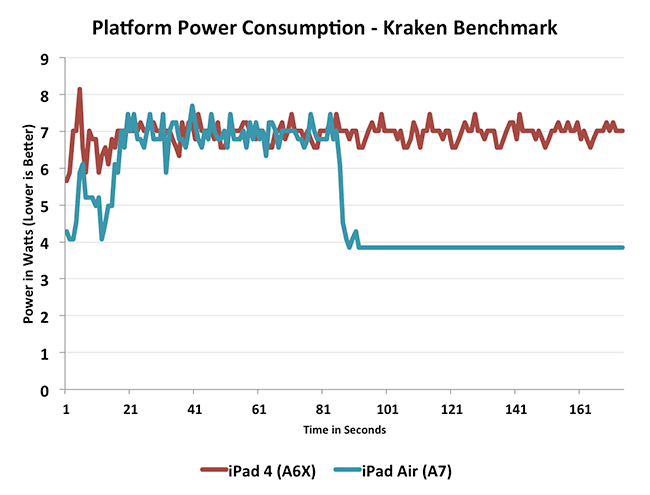
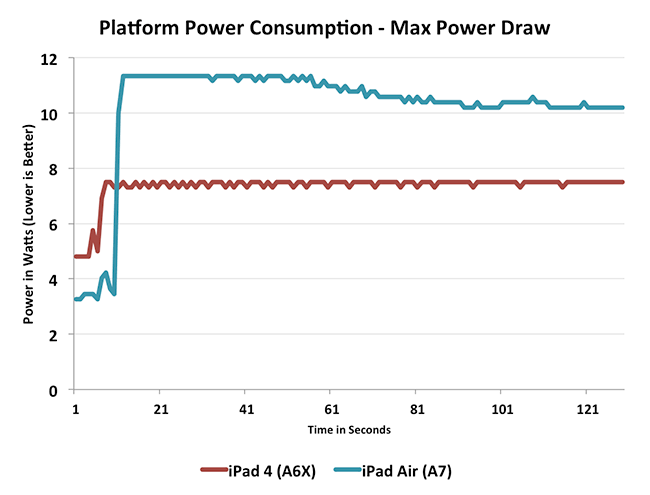








444 Comments
View All Comments
zogus - Tuesday, October 29, 2013 - link
Well, I've never had an iDevice crash on me , and I've owned iPhones since 2008.You know what they say about anecdotal evidences.darkcrayon - Wednesday, October 30, 2013 - link
I'm not sure if Anand meant a total system crash, or if he meant an app crashing due to memory use (iOS actually kills apps that request too much memory if they go overboard such that the system can't be maintained- since there is no swap file).basroil - Tuesday, October 29, 2013 - link
"It also seemed like 15-inch notebook computers were done for a couple of years ago, then Apple launched the MacBook Pro with Retina Display. "The year after, due to poor sales of the 15" model, Apple succumbed to the market and released a 13" model to offset losses.
blacks329 - Wednesday, October 30, 2013 - link
Really? So it only took them 4.5 months to go from no plan of ever releasing a 13" inch retina MBP to going through all the processes required to make and release it, because the 15" was losing money? What world do you live in? You have no idea what you're talking about.tipoo - Tuesday, October 29, 2013 - link
30% higher memory use is pretty huge, and on the same 1GB, 1GB 32 bit iOS devices already kicked Safari tabs out of memory and forced refreshes far more than I would like.ScottBoone - Tuesday, October 29, 2013 - link
Being an original iPad owner, I think the RAM situ on the iPad Air is going to turn out to be its achilles heal, just like the original. And when the original iPad first shipped, nearly ALL the reviewers bought the Apple PR line that "specs don't matter" blah blah blah. And sure enough, specs ABSOLUTELY mattered; the original iPad saw a premature end of life. All of the reviews **EXCEPT Anand's** have completely ignored the question of RAM: completely ignoring the fact that the iPad 3/4 already suffered from more RAM constraint than the 2 (thanks to the increased buffer size needed for the Retina screen), completely ignoring the 20-30% bigger footprint of 64-bit computing, completely ignoring that newer apps/iOS are bigger/hungrier beasts. Apple has a terrible track record of memory efficiency; I can't imagine the newest versions of iMovie and GarageBand using LESS RAM than their predecessors. Forget about the NEXT versions being more frugal. Given that the difference between the original iPad's inability to run iOS 6 (not to mention iOS 7) was 256MB of ram (under iOS 5, the original iPad has ~70MB free after device boot), and compounding the increased footprint of the buffers, iOS usage, and app growth...I can't imagine the iPad Air is going to be a long-term viable device. I'd be surprised if it enjoys a good user experience under iOS 9 (rather like the original iPad under iOS 5). Personally, I don't think Anand hammers Apple's choice of 1GB hard enough here, I guess only time will tell.aliasfox - Wednesday, October 30, 2013 - link
+100I'm typing this on an iPad 1. A 32GB iPad 1 with 3G, so a $700+ device. The 256MB of RAM is crippling. Even my iPhone 4, using the same chip but 20% slower and with twice the RAM, is much more usable for a lot of activities. In fact, the Facebook app automatically crashes on the iPad nine times out of ten on the iPad, but is perfectly fine on the iPhone. Aside from RAM, they're just about the same.
I love using my iPad when it works, but if I'm only going to get three years tops out of a device, you're gonna have a hard time convincing me to spend $700 on one again. Even $500 is a stretch.
KoolAidMan1 - Wednesday, October 30, 2013 - link
Should have sold it when the 2 came out. The iPad 2 is still a viable device after all this time, mainly because of the RAM situation.The original iPad is like the original iPhone 3G, good for a year but far surpassed by a predecessor with much more longevity.
aliasfox - Wednesday, October 30, 2013 - link
Would've, should've, could've. Now the resale value of a first generation iPad is less than the difference between a 16GB wifi and a 32GB LTE model. I like having more space and true GPS (not to mention occasional cellular usage), so it would be mildly annoying to go from a cellular model to a wifi only model. Sure, a lot of that could be made up for by the phone (which I got over a year after my iPad), but still...Maybe a cheaper iPad mini Retina would work better, despite the smaller screen size.
darkcrayon - Wednesday, October 30, 2013 - link
Yeah the iPad 1 had a premature demise, that was a mistake, but I don't think we're going to see that with the Air- I mean the iPad 2 had a much longer lifespan (hell, it's still being sold). But you could/should just sell your iPad after a year or two and use the money to upgrade. Mobile is clearly on a much faster growth schedule than traditional computers, tablets being somewhere closer to phones than laptops.